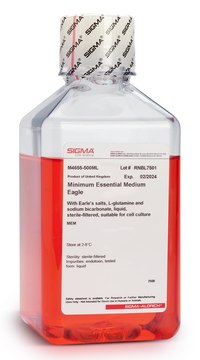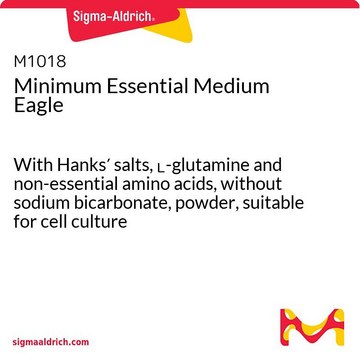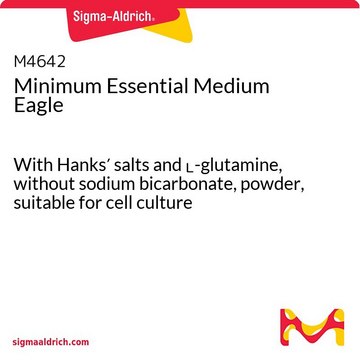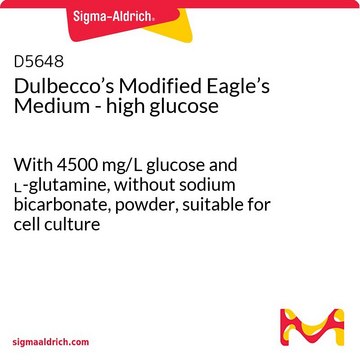M0268
Minimum Essential Medium Eagle
With Earle′s salts and L-glutamine, without sodium bicarbonate, powder, suitable for cell culture
Synonym(s):
EMEM, MEM
Sign Into View Organizational & Contract Pricing
All Photos(1)
About This Item
UNSPSC Code:
12352207
NACRES:
NA.75
Recommended Products
Quality Level
form
powder
technique(s)
cell culture | mammalian: suitable
components
HEPES: no
phenol red: yes
Earle’s salts (5% CO2): yes
NaHCO3: no
L-glutamine: yes
sodium pyruvate: no
shipped in
ambient
storage temp.
2-8°C
Looking for similar products? Visit Product Comparison Guide
General description
Minimum Essential Medium Eagle (MEM) is one of the most widely used synthetic cell culture media. MEM has been used for culturing several cells grown in monolayers. It is commonly used to grow attached cell lines, such as fibroblasts, in the presence of fetal bovine sera (FBS), calf, or horse sera.
Application
Minimum Essential Medium Eagle has been used:
- in the isolation and culture of primary hepatocytes
- to culture the human endometrial carcinoma cells Ishikawa (ATTC) and L-Wnt-3a cells (ATCC) that secrete Wnt family member 3a (Wnt-3a) ligand
- to culture the AN3CA (endometrial cancer cell line) cells, and HEC1-B human (endometrial adenocarcinoma cell line) cells
Features and Benefits
- Minimum Essential Medium Eagle (MEM) contains higher concentrations of amino acids to mimic the protein composition of cultured mammalian cells.
- The formulation has been altered by optional elimination of calcium to enable the growth of cells in suspension culture.
Quantity
Formulated to contain 9.5 grams of powder per liter of medium.
Reconstitution
Supplement with 2.2 g/L sodium bicarbonate.
Other Notes
Essentially the same as the original formula, except it is provided as a powder.
also commonly purchased with this product
Product No.
Description
Pricing
Storage Class Code
13 - Non Combustible Solids
WGK
WGK 2
Flash Point(F)
Not applicable
Flash Point(C)
Not applicable
Choose from one of the most recent versions:
Already Own This Product?
Find documentation for the products that you have recently purchased in the Document Library.
Customers Also Viewed
T L Freeman et al.
Biochemical pharmacology, 68(2), 223-230 (2004-06-15)
Activation of hepatic stellate cells (HSCs) involves the induction of ECM protein synthesis and rapid cell proliferation. Thus, agents that interfere with either process could potentially mitigate the development of liver disease by reducing the synthesis of proteins associated with
Jifu Mao et al.
ACS nano, 11(10), 10409-10416 (2017-09-08)
The poor mechanical properties and processability of pristine heterocyclic conductive polymers represent the most notable scientific and technological challenges that have greatly limited the application of these polymers. We report a soft and mechanically processable free-standing pristine polypyrrole (PPy) membrane
Xiaolong Sun et al.
Acta histochemica, 122(8), 151649-151649 (2020-11-10)
As one of the most frequent diabetic complications, diabetic foot ulcer (DFU) can cause limb ischemia or even amputation. Paeoniflorin (PF) has been reported to possess many kinds of biological functions, such as antioxidant and anti-inflammatory effects. However, the role
Enriqueta Garcia-Gutierrez et al.
PloS one, 11(3), e0150687-e0150687 (2016-03-02)
The metabolism of S. Typhimurium within infected host cells plays a fundamental role in virulence since it enables intracellular proliferation and dissemination and affects the innate immune response. An essential requirement for the intracellular replication of S. Typhimurium is the
Pablo Garcia-Valtanen et al.
Viruses, 12(5) (2020-05-28)
White adipose tissue (WAT) produces interleukin-10 and other immune suppressors in response to pathogen-associated molecular patterns (PAMPs). It also homes a subset of B-cells specialized in the production of IL-10, referred to as regulatory B-cells. We investigated whether viral stimuli
Our team of scientists has experience in all areas of research including Life Science, Material Science, Chemical Synthesis, Chromatography, Analytical and many others.
Contact Technical Service







